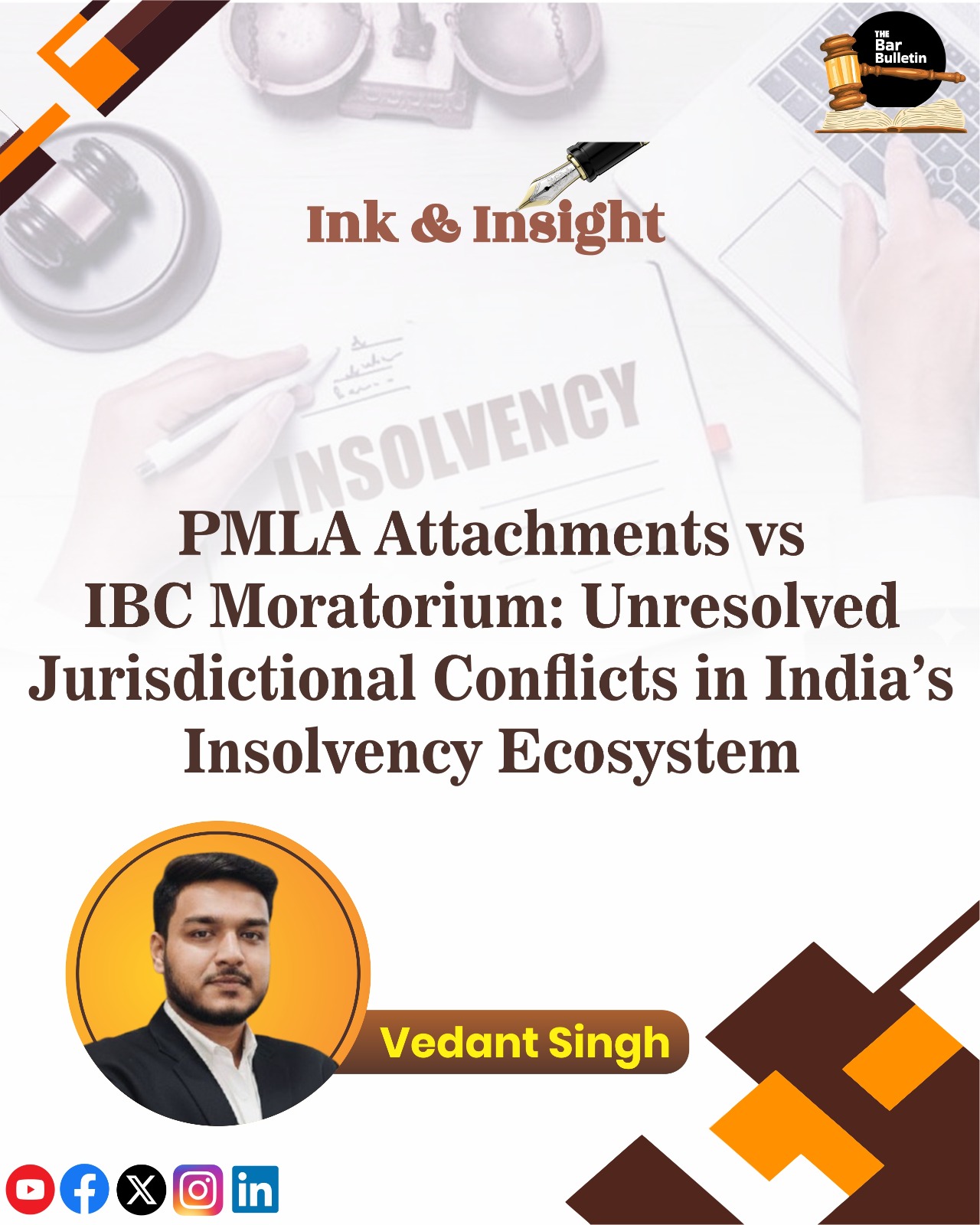India’s insolvency regime under the Insolvency and Bankruptcy Code, 2016 (“IBC”) has transformed the landscape for distressed asset resolution. However, an area of persistent legal uncertainty has emerged due to clashes between IBC proceedings and the attachment powers exercised by the Enforcement Directorate (“ED”) under the Prevention of Money Laundering Act, 2002 (“PMLA”). A fundamental legal question arises: Can the ED lawfully attach or retain attached properties of a corporate debtor undergoing Corporate Insolvency Resolution Process (“CIRP”)? This question lies at the heart of an ongoing jurisdictional conflict and carries significant implications for asset recovery, investor confidence, and the future of insolvency jurisprudence in India.
I. The IBC Framework and Its Protective Shield
Under Section 14 of the IBC, once a CIRP is initiated, a moratorium is imposed against any suits or proceedings, including enforcement or recovery actions, in respect of the corporate debtor’s assets. This moratorium is essential to preserve the debtor’s assets and maintain status quo, ensuring that the CIRP is conducted efficiently and equitably. Further, Section 238 of the IBC provides an overriding effect over any other law that is inconsistent with the provisions of the Code.
The moratorium and the non-obstante clause have become central to judicial interpretations when the ED’s attachment powers under the PMLA intersect with the CIRP.
II. PMLA Attachment Powers and the ED’s Justification
The PMLA is a quasi-criminal statute aimed at deterring money laundering. Sections 5 and 8 of the PMLA empower the ED to provisionally attach and, upon confirmation by the Adjudicating Authority, confiscate assets deemed to be proceeds of crime. The ED relies on Section 71 of the PMLA its own non-obstante clause, to argue that its enforcement actions override other statutory proceedings, including CIRP.
The ED’s contention is that assets acquired through criminal activity cannot be allowed to form part of the insolvency estate and that public interest in penalizing financial crimes must prevail over commercial claims.
III. Conflicting Judicial Pronouncements
Courts and tribunals have rendered divergent rulings on this matter, contributing to legal ambiguity.
In Rotomac Global Pvt. Ltd.[1], the NCLT, Mumbai Bench held that properties attached under the PMLA prior to the initiation of CIRP are not protected by the IBC moratorium. The reasoning was that such assets, being allegedly tainted, cannot be used to satisfy creditor claims.
In contrast, the NCLAT in Varrsana Ispat Ltd. v. Deputy Director[2], Directorate of Enforcement held that once the CIRP commences, the IBC moratorium under Section 14 extends to PMLA proceedings. A similar approach was adopted by the Delhi High Court in the Bhushan Power & Steel Ltd. [3]case, where the ED was restrained from taking possession of assets during CIRP.
The apex court in Vijay Madanlal Choudhary v. Union of India[4] upheld the constitutional validity of key PMLA provisions but did not conclusively address whether ED’s attachments survive the moratorium under the IBC. This has left the lower judiciary to resolve the interpretative clash in a piecemeal fashion, resulting in regulatory uncertainty.
IV. Section 32A and the Post-Resolution Shield
In response to such conflicts, the legislature introduced Section 32A to the IBC in 2020. It provides immunity to the corporate debtor and its assets once a resolution plan is approved and a change in control occurs. While the former management may still be prosecuted, the new management enjoys protection against prior criminal liabilities and confiscatory actions.
The Supreme Court in Manish Kumar v. Union of India[5] upheld the validity of Section 32A, stating that resolution applicants cannot be penalized for historical misdeeds of the corporate debtor. This provision now serves as a statutory bulwark, although its scope vis-à-vis existing PMLA attachments remains a grey area when such attachments are not lifted even after resolution.
V. Key Legal and Policy Questions
The overlapping jurisdictions of the IBC and PMLA raise critical questions:
1. Does the IBC’s non-obstante clause under Section 238 override the PMLA in the context of CIRP?
2. Can the ED attach or retain control over properties of a corporate debtor during the moratorium period?
3. What becomes of creditor rights if such assets are excluded from the insolvency estate due to attachment or confiscation?
These questions are not merely academic, they directly impact creditor recoveries, investor participation in CIRPs, and the credibility of India’s insolvency regime.
VI. Need for Institutional Coordination
India currently lacks a coordinated statutory mechanism akin to frameworks in jurisdictions like the UK, where the Insolvency Act and Proceeds of Crime Act (POCA) provide courts the discretion to balance competing interests of confiscation and insolvency resolution. There, insolvency professionals can apply for variances or access to criminally attached assets for the benefit of the creditor estate.
In the Indian context, overlapping proceedings often derail resolution efforts and discourage potential resolution applicants from stepping in, fearing future litigation or seizure of acquired assets.
VII. The Way Forward
To address the impasse, the following reforms merit serious consideration:
1.Judicial Clarification:The Supreme Court must deliver an authoritative ruling on the interplay between Section 14 of IBC and Sections 5 and 8 of PMLA, particularly in cases where attachments are made post-initiation of CIRP.
2.Legislative Amendment:Either the IBC or the PMLA must be amended to lay down clear rules on statutory precedence and carve-outs for insolvency resolution in cases involving financial crimes.
3.Inter-agency Coordination Mechanism:A statutory panel comprising representatives of the ED, IBBI, and the NCLT could be constituted to mediate such disputes, ensuring real-time resolution and avoiding duplicative litigation.
VIII. Conclusion
As India advances towards a more robust insolvency ecosystem, reconciling the objectives of the IBC and PMLA is not merely a legal imperative, it is an economic necessity. Without definitive judicial guidance and legislative intervention, resolution processes entangled in criminal proceedings will continue to deter investors and undermine creditor confidence. A coherent, coordinated framework is essential to ensure that the pursuit of justice does not come at the cost of economic revival.
*Advocate, JKS Legal. He can be reached at jkslawyers@gmail.com
[1] Rotomac Global Pvt. Ltd., NCLT Mumbai Bench, CP No. 1371/MB/2018 (2021).
[2] Varrsana Ispat Ltd. v. Deputy Director, Directorate of Enforcement, Company Appeal (AT) (Insolvency) No. 493 of 2019 (NCLAT).
[3] Bhushan Power & Steel Ltd. v. Enforcement Directorate, W.P.(C) 11459/2019 (Delhi High Court).
[4] Vijay Madanlal Choudhary v. Union of India, (2022) 10 SCC 203.
[5] Manish Kumar v. Union of India, (2021) 5 SCC 1.

